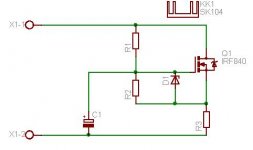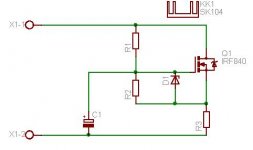Disco,
with SS rectification, I'm curious whether you tried adding RC snubbers across the SS diodes, per Hagerman's paper? That is supposed to cut the hash out, but I haven't gotten to that yet.
The other problem with power supply RF hash, especially from SS with input caps of some size, including filament rectification, is that there's RF "spray" going all over the amp; it doesn't have to be transmitted just in the B+ rail itself, although the B+ rail certainly makes a nice reception/transmission antenna.
Best, Charlie
with SS rectification, I'm curious whether you tried adding RC snubbers across the SS diodes, per Hagerman's paper? That is supposed to cut the hash out, but I haven't gotten to that yet.
The other problem with power supply RF hash, especially from SS with input caps of some size, including filament rectification, is that there's RF "spray" going all over the amp; it doesn't have to be transmitted just in the B+ rail itself, although the B+ rail certainly makes a nice reception/transmission antenna.
Best, Charlie
radianceaudio said:Disco,
with SS rectification, I'm curious whether you tried adding RC snubbers across the SS diodes, per Hagerman's paper? That is supposed to cut the hash out, but I haven't gotten to that yet.
The other problem with power supply RF hash, especially from SS with input caps of some size, including filament rectification, is that there's RF "spray" going all over the amp; it doesn't have to be transmitted just in the B+ rail itself, although the B+ rail certainly makes a nice reception/transmission antenna.
Best, Charlie
Hi Charlie,
It's a couple of years ago I did these calculations for the last time, as SS is not my usual way to go and my experimental amps don't exist for a long time. Some engeneers advice to put something from 20nF to 120nF over the secundary as a common cure, among them not the least like Jones and our local hero Van der Veen.
You must try the Swenson if you find the time, it delivers what it promises. After reading M Jones' book I build several Maida regs. Up to 300V and 100mA they work nicely but drifted severely when pushed over that threshold. Got quite hot too. After that I tried to develop my own pass and shunt regs but lacked the electronics skills it takes. Thanks to the knowledge and effort of people like Gary and John we amateurs get around.
Best regards,
I know some people overhere who've spent at least three years achieving the same sound from their DHTs on DC as on AC 😀radianceaudio said:.. filament rectification
Airwound coils, large cap banks, very large chokes even tube rectified filement supplies. In the end it came down to filtering common mode noise .
gyrator
I have a small amp for a small enclosure in the planning. So i have to use what is called here sand in the psu. I am thinking of trying out a gyrator + the swenson regulator. I have no room for a real choke.
Could a gyrator be of help in keeping garbage out ?
If so, this could also be of use in the amp discussed here.
Jaap-2
I have a small amp for a small enclosure in the planning. So i have to use what is called here sand in the psu. I am thinking of trying out a gyrator + the swenson regulator. I have no room for a real choke.
Could a gyrator be of help in keeping garbage out ?
If so, this could also be of use in the amp discussed here.
Jaap-2

Re: gyrator
In theory it should be possible to exchange the choke for a gyrator but I don't have experience with it. Looking for a HV unit I came across this page.
Jaap said:I have a small amp for a small enclosure in the planning. So i have to use what is called here sand in the psu. I am thinking of trying out a gyrator + the swenson regulator. I have no room for a real choke.
Could a gyrator be of help in keeping garbage out ?
If so, this could also be of use in the amp discussed here.
Jaap-2
In theory it should be possible to exchange the choke for a gyrator but I don't have experience with it. Looking for a HV unit I came across this page.
I know some people overhere who've spent at least three years achieving the same sound from their DHTs on DC as on AC
Airwound coils, large cap banks, very large chokes even tube rectified filement supplies. In the end it came down to filtering common mode noise .
Yeah, that's precisely what has me bugged right now...although it's a bit off-topic, but really the same...whether it's filaments or HV we're still considering noise and impedance.
I read that link you provided, what a great website!!
My only question was this: with small signal tubes, I normally bias the filaments 90 volts positive to the cathode. Doing this, I don't hear any noise or ripple I attribute to the filament or filament supply, AC or DC.
Yet in gboers analysis, he had to ground one end of his dummy filament load to remove the noise.
So, now I'm wondering, well...which works better, biasing the filaments and running AC, or running the filaments with one side grounded and DC?

I simply must get a storage scope...not being able to visualize hash and noise on my plain analog 20 MHz scope is driving me nuts.
Best, Charlie
Gingertube was looking into gyrators, maybe he can chime in?
That schematic has the following values:
R1, R2 330kOhm
C1 4.7uF
D1 ZD15
R3 33Ohm
Q1 IRF840
The formula for calculating the inductance is:
Value in Henries is approximately R1 x R3 X C1
That is 330K x 33 x 4u7 = 50H
I say approximately because this assumes that the gain from gate to source is exactly = 1 and in practice it will be a bit less than 1
Link here: http://www.loetstelle.net/projekte/gyrator/gyrator.php
That schematic has the following values:
R1, R2 330kOhm
C1 4.7uF
D1 ZD15
R3 33Ohm
Q1 IRF840
The formula for calculating the inductance is:
Value in Henries is approximately R1 x R3 X C1
That is 330K x 33 x 4u7 = 50H
I say approximately because this assumes that the gain from gate to source is exactly = 1 and in practice it will be a bit less than 1
Link here: http://www.loetstelle.net/projekte/gyrator/gyrator.php
Attachments
A note of caution:
I suggest caution in using a gyrator as the 1st element in a PSU filter. There is a substantial forward drop in the circuitry, as the power to operate the FET has to come from someplace. The comment about not being able to swing above the DC value may be relevant too. Remember, the 1st inductor in a choke I/P filtered PSU operates under rather severe AC conditions.
I think the best use of a gyrator is probably in a Π section filter. The value of the I/P cap can be kept relatively small, which reduces "hash" and power trafo heating.
I suggest caution in using a gyrator as the 1st element in a PSU filter. There is a substantial forward drop in the circuitry, as the power to operate the FET has to come from someplace. The comment about not being able to swing above the DC value may be relevant too. Remember, the 1st inductor in a choke I/P filtered PSU operates under rather severe AC conditions.
I think the best use of a gyrator is probably in a Π section filter. The value of the I/P cap can be kept relatively small, which reduces "hash" and power trafo heating.
Lacking the 840 I used an IRF820 instead. Boy, this thing resonates at startup. Radio reception in the next room was severely influenced 🙁 If you like another 'trick choke' see http://www.antiquewireless.org/otb/resto0504.htm but for me it's opposite to what a filter should do: removing HF noise and ripple.
There's a high-voltage reg in the March Elektor UK magazine. Anybody looked at that one?
Jan Didden
Jan Didden
I've finished the Swenson regulator in it's original version. As Gary suggested I increased C2 to 10uF and C1 to 470nF. It works very good indeed but there is one thing bothering me. When it's situated in an amplifier enclosure it suffers from thermal drift. Not much though, it's drifting from 275V to 280V within 5 minutes. I wondered if the use of a mix of metal film and carbon resistors for the voltage reference (800K ohm) would bring a solution because of their opposed Temperature Coefficient. Or might the drift be caused by the MOSFETs warming up? (the heatsink on Q2 gets lukewarm).
Yes, Jan, thanks for that link - looks interesting!
Disco - that gyrator didn't work as expected then?
Disco - that gyrator didn't work as expected then?
Nice article
Hi all
This is a very interresting thread. I'm in the middle of this having done some extensive tests myself lately on a Tube regulator, slightly modified from the no.3 figure of the article in Audio Xpress, with a 6u8a and a7233 pass tube instead of the ECF80 and EL34.
I'm glad Jan you pointed us to the article in the latest Elector. Very interresting and versatile regulator to test. I bought the article yesterday for 10 Elector credits. 🙂
T-REG A high-voltage regulator for valve amps
janneman said:There's a high-voltage reg in the March Elektor UK magazine. Anybody looked at that one?
Jan Didden
Hi all
This is a very interresting thread. I'm in the middle of this having done some extensive tests myself lately on a Tube regulator, slightly modified from the no.3 figure of the article in Audio Xpress, with a 6u8a and a7233 pass tube instead of the ECF80 and EL34.
I'm glad Jan you pointed us to the article in the latest Elector. Very interresting and versatile regulator to test. I bought the article yesterday for 10 Elector credits. 🙂
T-REG A high-voltage regulator for valve amps
I have also built the LM317 regulator pretty as-specified in the National app note in my preamp. It's handling the plates for 6 12AU7s and seems to work well. The rest of the preamp is still not complete, so I haven't really tortured it too much but I was happy with the sound while it was jury-rigged for a year or two.
janneman said:There's a high-voltage reg in the March Elektor UK magazine. Anybody looked at that one?
Jan Didden
Just arrived stateside...where's the phase-gain plot? (just kiddin')
Hi Jack,
-Chris
That may contribute to the "sound" of a regulator, so you have asked a valid question. An active regulator is still an amplifier with a reference voltage as the signal.where's the phase-gain plot? (just kiddin')
-Chris
Yeah, yeah, yeah. But in hindsight, I probably should have given more details about the drop-out voltage, which for a tube reg can be considerable. As well as the value of the resevoir caps wrt the load current.
Then again, a friend once told me to leave in some white areas to encourage reactions...
Jan Didden
Then again, a friend once told me to leave in some white areas to encourage reactions...
Jan Didden
- Status
- Not open for further replies.
- Home
- Amplifiers
- Tubes / Valves
- Look for high-voltage regulator projects

